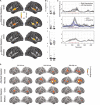Cortical tracking of voice pitch in the presence of multiple speakers depends on selective attention
- PMID: 36003957
- PMCID: PMC9393379
- DOI: 10.3389/fnins.2022.828546
Cortical tracking of voice pitch in the presence of multiple speakers depends on selective attention
Abstract
Voice pitch carries linguistic and non-linguistic information. Previous studies have described cortical tracking of voice pitch in clean speech, with responses reflecting both pitch strength and pitch value. However, pitch is also a powerful cue for auditory stream segregation, especially when competing streams have pitch differing in fundamental frequency, as is the case when multiple speakers talk simultaneously. We therefore investigated how cortical speech pitch tracking is affected in the presence of a second, task-irrelevant speaker. We analyzed human magnetoencephalography (MEG) responses to continuous narrative speech, presented either as a single talker in a quiet background or as a two-talker mixture of a male and a female speaker. In clean speech, voice pitch was associated with a right-dominant response, peaking at a latency of around 100 ms, consistent with previous electroencephalography and electrocorticography results. The response tracked both the presence of pitch and the relative value of the speaker's fundamental frequency. In the two-talker mixture, the pitch of the attended speaker was tracked bilaterally, regardless of whether or not there was simultaneously present pitch in the speech of the irrelevant speaker. Pitch tracking for the irrelevant speaker was reduced: only the right hemisphere still significantly tracked pitch of the unattended speaker, and only during intervals in which no pitch was present in the attended talker's speech. Taken together, these results suggest that pitch-based segregation of multiple speakers, at least as measured by macroscopic cortical tracking, is not entirely automatic but strongly dependent on selective attention.
Keywords: TRF; auditory cortex; cocktail party; mTRF; temporal response functions.
Copyright © 2022 Brodbeck and Simon.
Conflict of interest statement
The authors declare that the research was conducted in the absence of any commercial or financial relationships that could be construed as a potential conflict of interest.
Figures



Similar articles
-
Cortical responses time-locked to continuous speech in the high-gamma band depend on selective attention.Front Neurosci. 2023 Dec 14;17:1264453. doi: 10.3389/fnins.2023.1264453. eCollection 2023. Front Neurosci. 2023. PMID: 38156264 Free PMC article.
-
Cortical Responses Time-Locked to Continuous Speech in the High-Gamma Band Depend on Selective Attention.bioRxiv [Preprint]. 2023 Oct 15:2023.07.20.549567. doi: 10.1101/2023.07.20.549567. bioRxiv. 2023. Update in: Front Neurosci. 2023 Dec 14;17:1264453. doi: 10.3389/fnins.2023.1264453. PMID: 37546895 Free PMC article. Updated. Preprint.
-
Linguistic processing of task-irrelevant speech at a cocktail party.Elife. 2021 May 4;10:e65096. doi: 10.7554/eLife.65096. Elife. 2021. PMID: 33942722 Free PMC article.
-
Stimulus-dependent activations and attention-related modulations in the auditory cortex: a meta-analysis of fMRI studies.Hear Res. 2014 Jan;307:29-41. doi: 10.1016/j.heares.2013.08.001. Epub 2013 Aug 11. Hear Res. 2014. PMID: 23938208 Review.
-
Affective and linguistic processing of speech prosody: DC potential studies.Prog Brain Res. 2006;156:269-84. doi: 10.1016/S0079-6123(06)56014-5. Prog Brain Res. 2006. PMID: 17015085 Review.
Cited by
-
Dynamics of Pitch Perception in the Auditory Cortex.J Neurosci. 2025 Mar 19;45(12):e1111242025. doi: 10.1523/JNEUROSCI.1111-24.2025. J Neurosci. 2025. PMID: 39909567
-
EEG-based cross-subject passive music pitch perception using deep learning models.Cogn Neurodyn. 2025 Dec;19(1):6. doi: 10.1007/s11571-024-10196-9. Epub 2025 Jan 3. Cogn Neurodyn. 2025. PMID: 39758357
-
Cocktail party training induces increased speech intelligibility and decreased cortical activity in bilateral inferior frontal gyri. A functional near-infrared study.PLoS One. 2022 Dec 1;17(12):e0277801. doi: 10.1371/journal.pone.0277801. eCollection 2022. PLoS One. 2022. PMID: 36454948 Free PMC article.
-
Attentional Modulation of the Cortical Contribution to the Frequency-Following Response Evoked by Continuous Speech.J Neurosci. 2023 Nov 1;43(44):7429-7440. doi: 10.1523/JNEUROSCI.1247-23.2023. Epub 2023 Oct 4. J Neurosci. 2023. PMID: 37793908 Free PMC article.
-
Neural encoding of melodic expectations in music across EEG frequency bands.Eur J Neurosci. 2024 Dec;60(11):6734-6749. doi: 10.1111/ejn.16581. Epub 2024 Oct 29. Eur J Neurosci. 2024. PMID: 39469882 Free PMC article.
References
-
- Boersma P., Weenink D. (2017). Praat: Doing Phonetics by Computer [Computer program]. Available online at: http://www.praat.org/ (aceessed April 2021).
Grants and funding
LinkOut - more resources
Full Text Sources

